5 eCommerce Trends to Watch in 2022
With millions of consumers worldwide now shopping online first, the stakes have never been higher for eCommerce retailers. The skyrocketing level of competitionCompetition
Businesses generally know who their competitors are on the open market. But are they the same companies you need to fight to get the best placement for your website? Not necessarily!
Learn more means enterprise leaders must embrace emerging and current eCommerce trends in 2022 to grab their share of an ever-growing market.
Kaleido Intelligence predicts that spending on B2B and B2C eCommerce will reach $6 trillion in 2022 , up from $4.8 trillion in 2020. And a look at data from Conductor shows major spikes in Google searches for B2B eCommerce in particular over the past year:
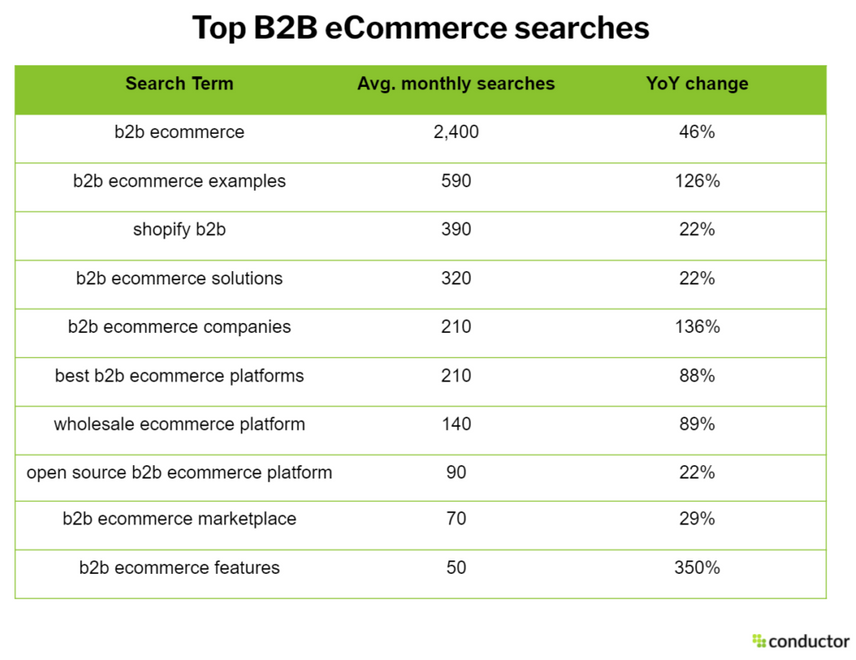
Whether you’re a B2B or B2C company, one thing is clear: customer experience (CX) is now the primary brand differentiator. That’s why the most successful B2B and B2C brands are taking every possible step to improve their CX and boost conversionConversion
Conversions are processes in online marketing that lead to a defined conclusion.
Learn more rates, average order value, annual recurring revenue, and customer loyalty.
To help you figure out what to prioritize in 2022, Conductor combed through search data and identified the top five eCommerce trends brands will embrace in the new year.
1. Website optimization
You can’t get traffic to your eCommerce website without finding new ways to increase your site’s rankingsRankings
Rankings in SEO refers to a website’s position in the search engine results page.
Learn more and visibility. That’s why website optimization ranks as the top trend in the eCommerce industry.
Many of the leading eCommerce enterprises rely on outside experts to help with search engineSearch Engine
A search engine is a website through which users can search internet content.
Learn more optimization. Searches for “best eCommerce SEO services” saw a whopping 600% year-over-year (YoY) change. In the B2B space, searches for “B2B eCommerce web design” and “B2B eCommerce website development” also showed more than 100% growth YoY.
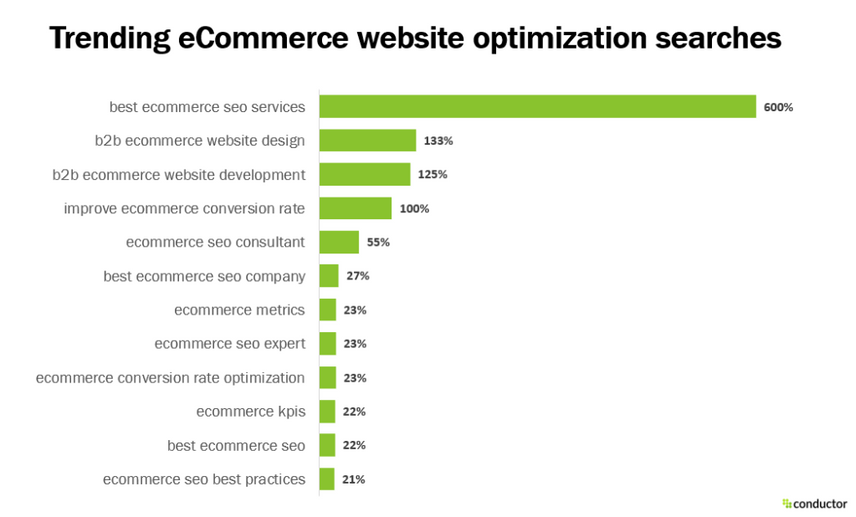
These results follow trends we’ve seen across industries. Conductor’s State of Digital Transformation 2021 report showed searches for website redesign-related terms grew by 9% during the pandemic, with spikes occurring annually every January as companies prepared for the start of a new year. We expect the same spike in January 2022.
For B2B and B2C eCommerce retailers, website optimization helps to improve on-page and off-page SEO, eliminate technical errors, and enhance the visibility of product page and blog content—all of which ultimately increases conversion rates. See how Solstice Sunglasses achieved a 72% increase in revenue through website optimization.
2. Analytics, machine learning, and AI
We live in the era of Big Data. For B2B and B2C retailers, that means the more information they can get, the better they’ll perform. So, it’s no surprise that the next market trend priority for retailers in 2022 is analytics, supported by two emerging technologies—machine learning and artificial intelligence (AI)—that help brands improve the quality of their metrics.
Data sourced from the Conductor platform shows the term “eCommerce analytics” has an average of 720 monthly searches. When collectively looking at related terms for eCommerce analytics, we see that it amounts to nearly 28,000 people monthly looking to find more information on the topic. Overall, analytics searches for eCommerce increased 36% YoY. Even more impressive, searches for “machine learning in eCommerce” saw a 52% boost YoY, including a 23% increase over the last few months of 2021. This suggests strong interest from retailers in incorporating machine learning to their analytics in 2022.
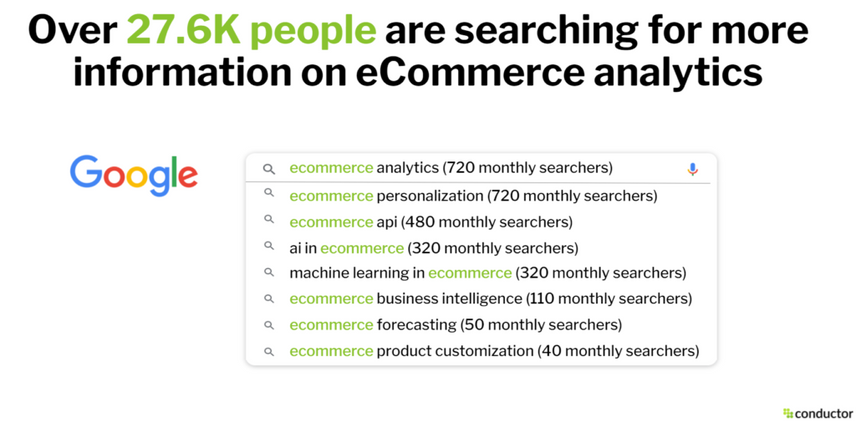
Current eCommerce developments show that retailers use machine learning today to analyze purchase history and make personalized product recommendations. They use AI to create accurate and dynamic pricing that shifts with market demand. On the back end, AI also helps brands improve logistics by forecasting transit times and shipping delays. As systems receive real-time data, machine learning helps their systems learn from that data and improve projections and predictions over time in order to adapt faster.
Strong YoY increases for enterprise resource management (ERP) solutions, express tracking, and integration-related searches reflect another big trend in eCommerce today: the use of application programming interfaces (APIs). Because APIs help integrate a brand’s ERP with its CRM database, order management system, content management system, and other key technologies, they give brands unified data from multiple sources they can then use to improve CX.
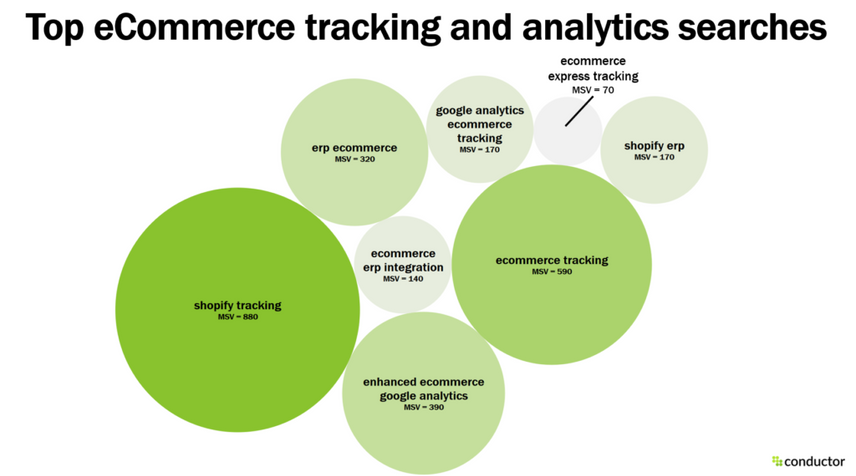
3. Augmented reality (AR)
How do you get people to “try on” a physical product during an online shopping visit? It’s been a pain point that’s plagued eCommerce for over two decades. But when it comes to current eCommerce developments, one technology in particular—AR—is expected to be a game-changer. Because AR technology augments the real world, it allows people to virtually try on makeup and clothes and see how household items might fit inside their homes using the camera built right into their iOS or Android device.
Popular eyeglasses brand Warby Parker was among the earliest adopters of AR eCommerce in 2019, using AR and facial recognition software to help customers see how their new frames would look on them. It didn’t take long for AR to move up the list of what’s trending in eCommerce as other brands looked to emulate this experience.
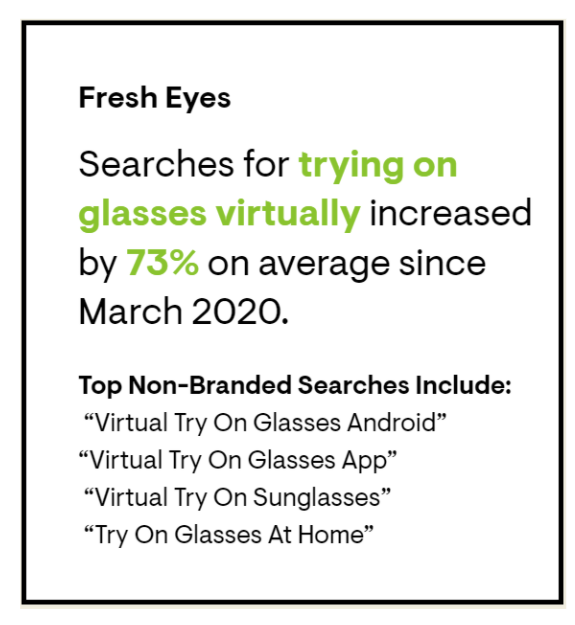
Now, multiple eCommerce brands are joining the AR craze. According to ABI research, more than 120,000 stores will use AR in 2022, and top eCommerce platform Shopify is helping retailers create or improve their AR capabilities. Conductor’s search engine data shows that Shopify’s AR landing page draws an estimated 235 clicks per month.
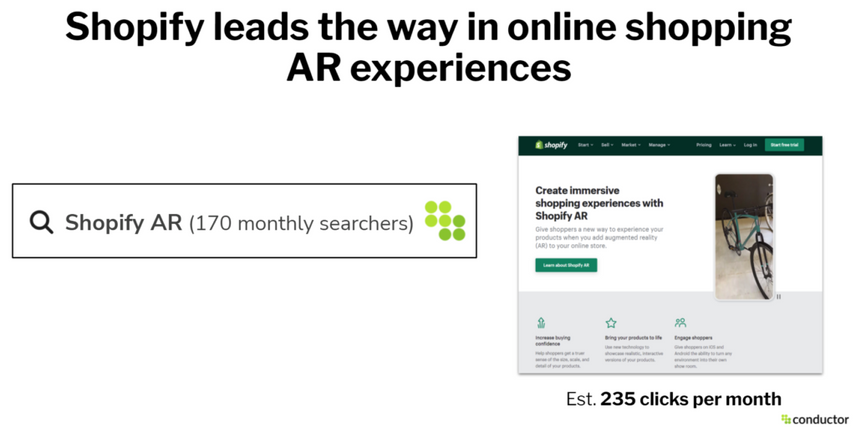
AR is exceptionally popular with both retailers and shoppers. A Deloitte survey of 15,000 consumers indicated that 76% want to use AR as a tool in their everyday life. Benefits of AR in eCommerce include lower return rates, longer shopping sessions, and higher customer confidence.
Some top AR eCommerce examples include Kohl’s AR virtual closet , in partnership with Snapchat, which lets shoppers try on athleisure and other apparel. Ulta’s virtual try-on GLAMLab —which allows shoppers to sample makeup options—saw a seven-fold increase in engagement during the COVID-19 pandemic.
Harvard Business Review predicts gamified AR as the next market trend for online shopping. One interesting example: Burberry’s B Surf Mobile Racing Game , in which characters wear items from the luxury apparel brand’s summer line. Hit the high score and you get a link to explore the full collection on Burberry’s website.
4. Social commerce
In their quest to make the online shopping experience as friction-free as possible, brands are embracing social commerce like never before. We’ve seen a 28% increase in “social commerce” search volumeSearch Volume
Search volume refers to the number of search queries for a specific keyword in search engines such as Google.
Learn more over the past year, making it fourth on our list of what’s trending in eCommerce in 2022.
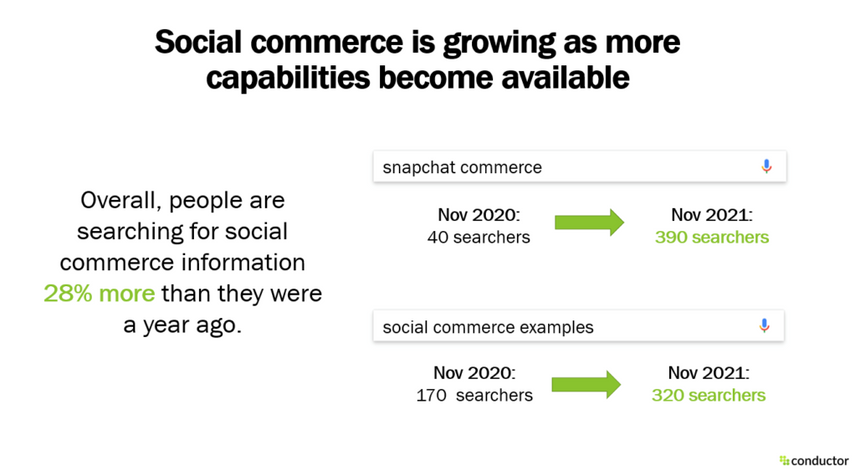
With social commerce, brands share products directly with consumers within a social media platform. Doing so creates a more seamless experience for consumers, who can buy in-app with only one or two taps. Social commerce helps eCommerce businesses reach new audiences, convert more customers, and boost the quality of social proof (reviews and recommendations) shared on social networks. According to Sprout Social, about 8 in 10 eCommerce brands expect to sell their products via social media over the next three years.
A look at the most searched social commerce platforms shows Snapchat leading the way. Snapchat has shown remarkable growth this year, with 306 million active daily users—an increase of 23% YoY— and four consecutive quarters of 20% growth.
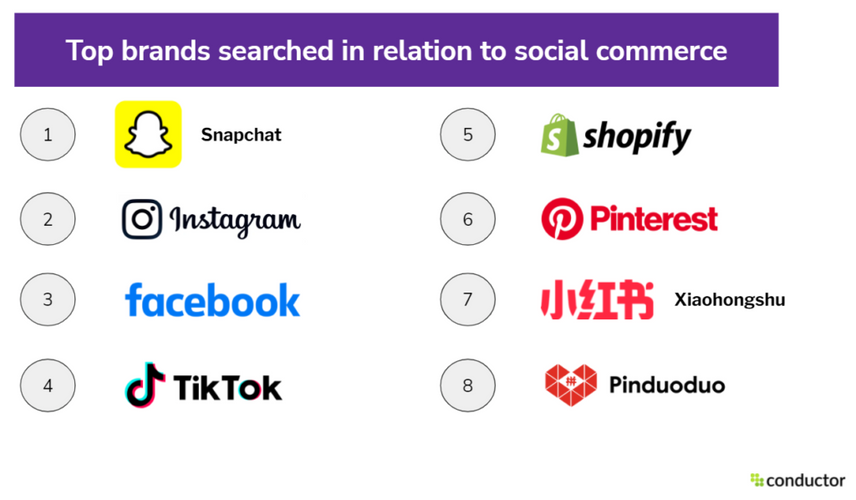
Snapchat has also invested heavily in AR. In May 2021, they opened up their in-app AR filters , called Lenses, to any eCommerce business with a Snapchat presence. That means shoppers who visit a retailer’s Snapchat page can virtually try on any product in their catalog and then purchase it without leaving the app.
In 2020 and 2021, nearly every other major social media platform rolled out new features to make in-app shopping easier for consumers. TikTok, already used by fashion influencers who have sparked trends for Halara dresses, denim, and even a shirt popularized by seven-time 2021 Grammy nominee Olivia Rodrigo, entered a new social commerce partnership with Shopify. It allows business accounts on TikTok to add a shopping tab to their profiles and create mini checkouts in-app.
Facebook now offers retailers and consumers video-infused Live Shopping options. Instagram boosted its social commerce game by introducing a feature that promotes a company’s new product drops . Pinterest’s Product Pins feature lets users create their own shopping lists in-app. And even Twitter is introducing a range of shopping experiments expected throughout 2022.
5. Subscriptions, rewards, and loyalty programs
The B2B world has perfected the art of Software as a Service (SaaS), offering companies the solutions they need on a subscription basis. Now, the B2C world is discovering the value of subscription boxes and subscription plans, too. Searches for “subscription boxes for men” achieved an average MSV of 27,100 over the past year, with a serious spike during the holiday season.
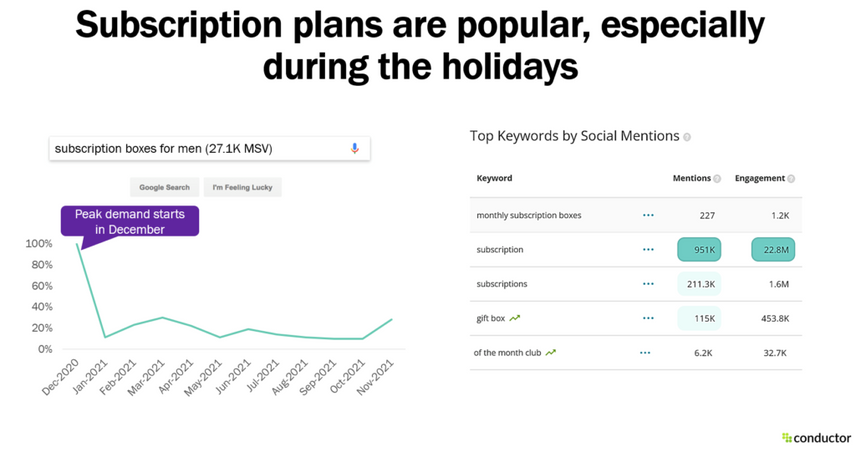
Subscription boxes are hot holiday gifts—and popular sellers year-round—because they’re relatively low cost, convenient, and offer consumers a new surprise on a recurring basis. Today, you can get a subscription box for multiple products, from apparel and pet supplies to wine and beauty supplies. For eCommerce businesses, subscriptions boost customer loyalty, increase annual recurring revenue, and provide valuable first-party consumer data.
While subscription boxes are one of the trends in the eCommerce industry today, loyalty programs also continue to surge, with major brands adding new features and perks to their offerings. Gap, for example, launched a refreshed loyalty program this year in July that lets customers earn rewards at four of their brands—Old Navy, Gap, Banana Republic, and Athleta.
After reviewing Conductor search engine data, we broke down the top trending branded online incentive plans into four categories—subscription, loyalty, rewards, and membership.
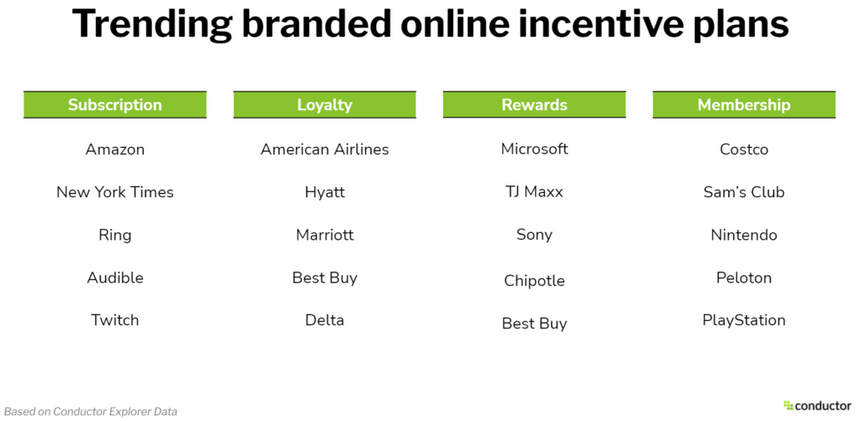
One brand that brings all of these together is Amazon. They’ve become the world’s largest eCommerce site on the back of their Prime Membership program , which has been expanded to include perks like grocery delivery through Amazon Fresh . Amazon now offers more than 400 subscription box options, and they allow third-party retailers to sell and manage their subscription box products on Amazon.
Get ahead of the hottest eCommerce trends in 2022
Not every eCommerce company aspires to become as large as Amazon, but each one is looking to carve out their slice of the online shopping market. The sooner B2B and B2C companies take advantage of these top five emerging and current trends in eCommerce, the more they’ll deliver when it comes to an improved CX and increased revenue.
If you’re interested in exploring website optimization to improve SEO and conversion rates on your eCommerce site, learn how Conductor can help.







